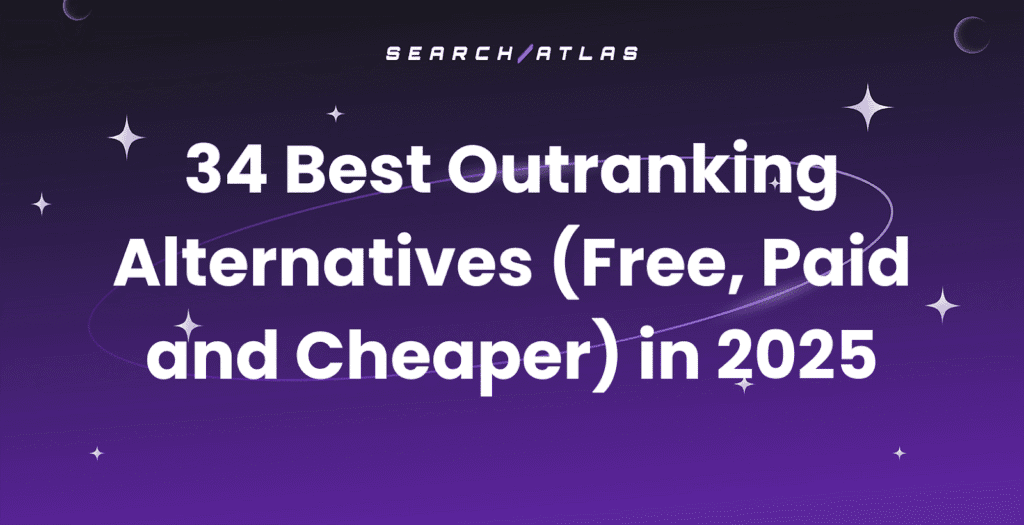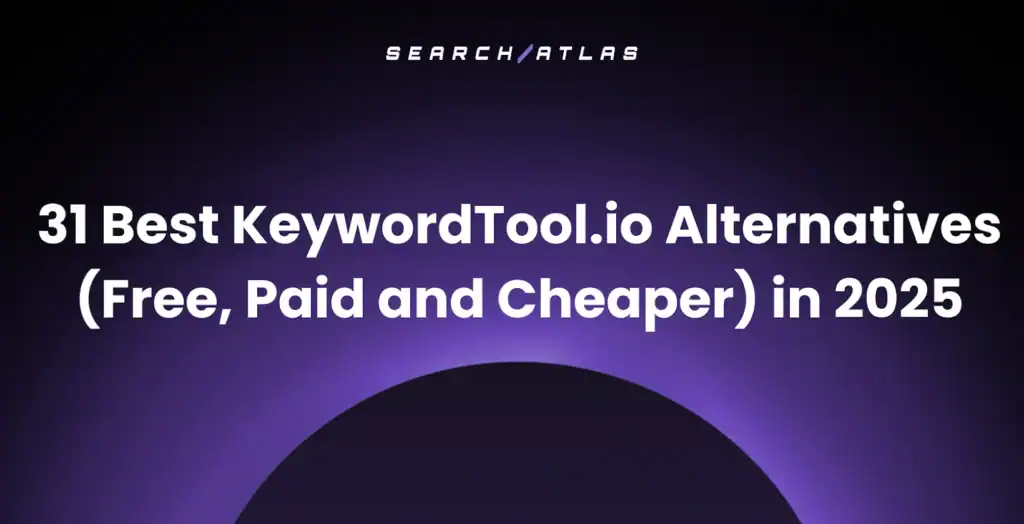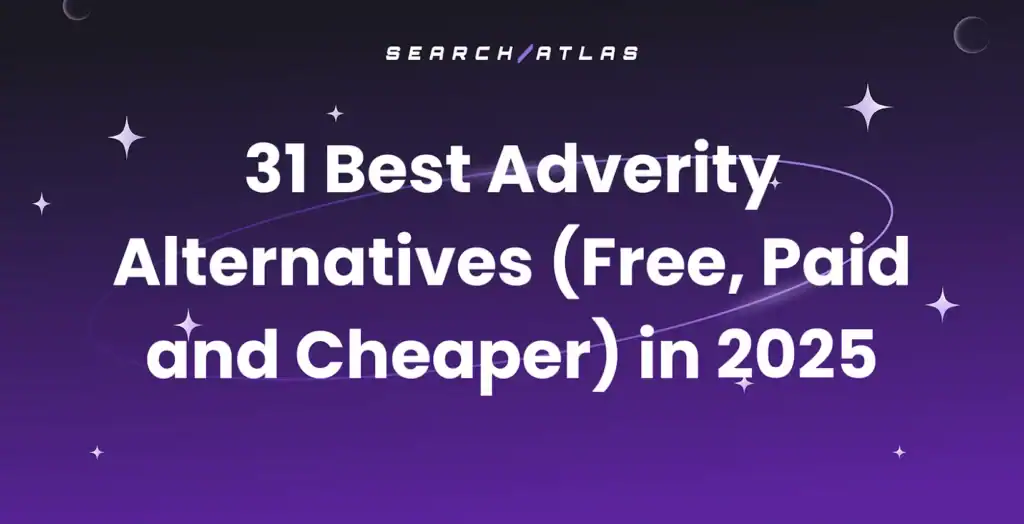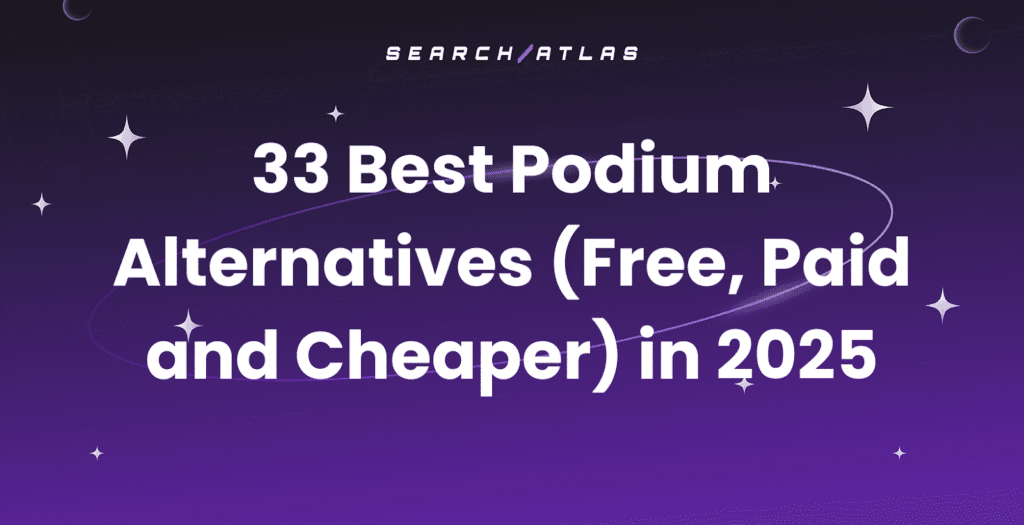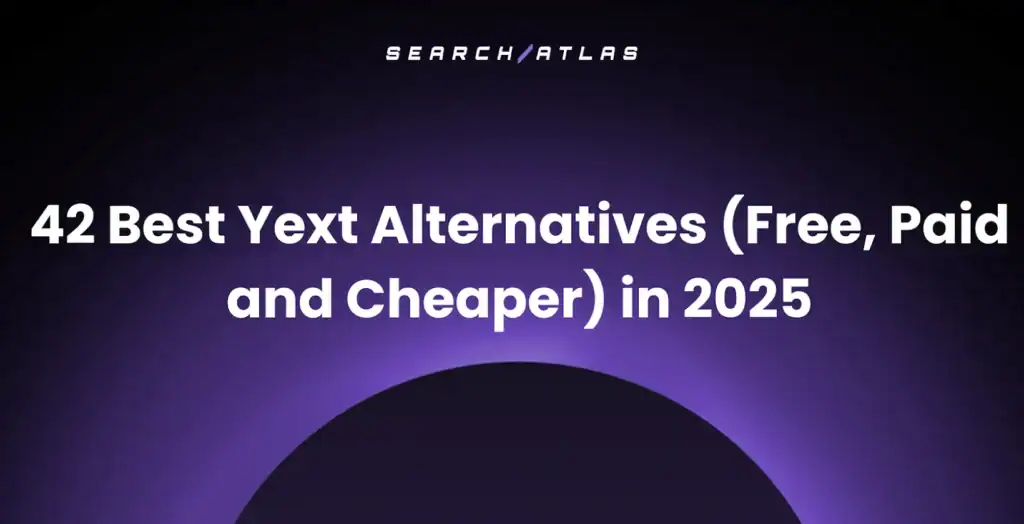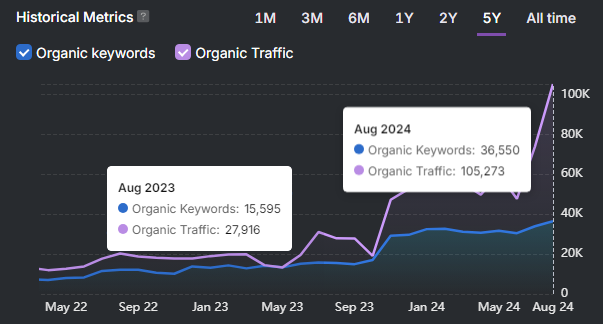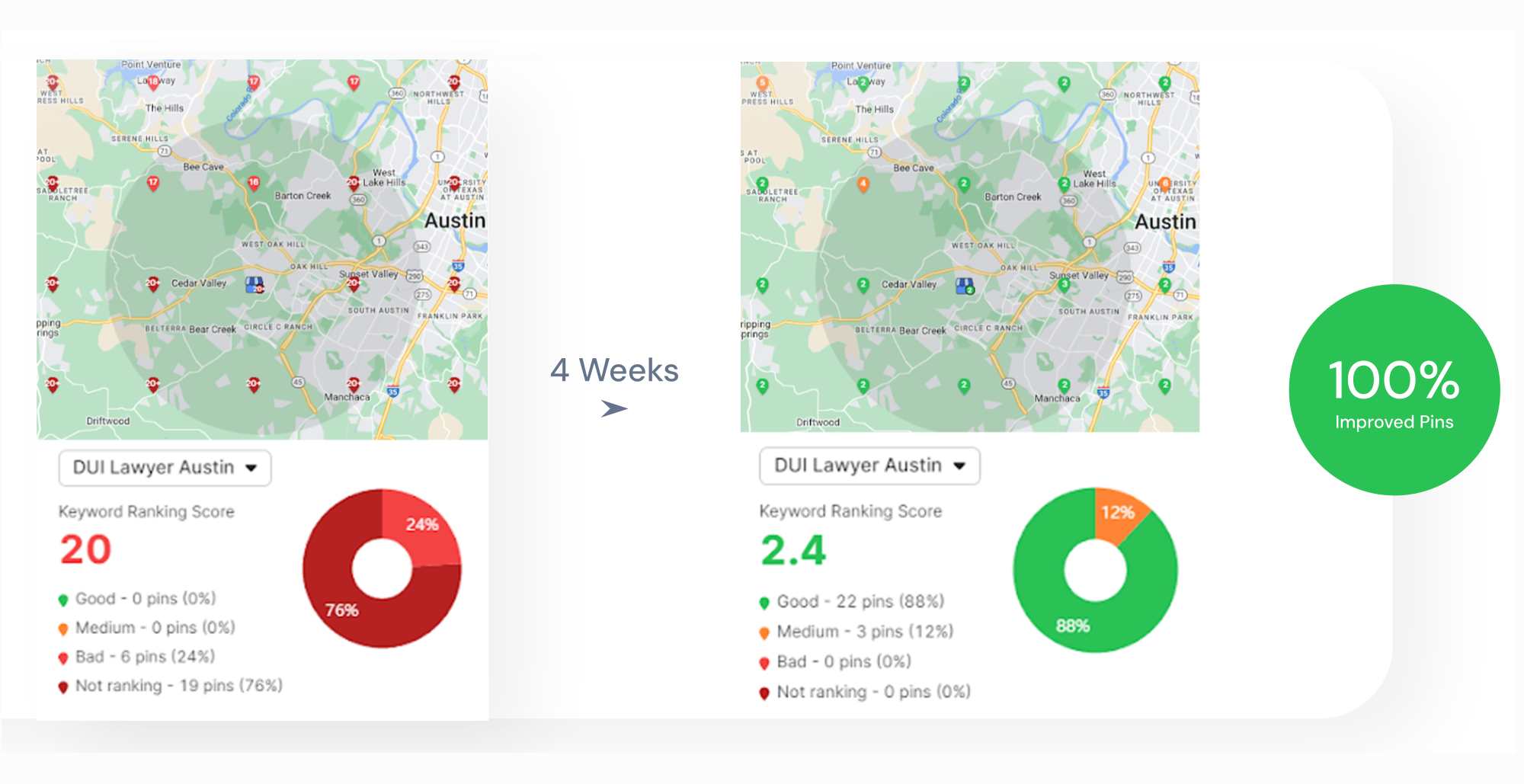Google’s E-E-A-T (Experience, Expertise, Authoritativeness, Trustworthiness) is a quality evaluation system outlined in Google’s Search Quality Rater Guidelines. E-E-A-T represents the core principles Google’s quality raters use to assess if the search results are providing helpful, relevant information to users. Google officially added the extra “E” for Experience in December 2022, expanding the previous E-A-T framework to capture the importance of firsthand knowledge in content creation.
The importance of Google E-E-A-T is its direct influence on SEO rankings, particularly for sensitive or impactful content like health, finance, and legal topics, collectively known as Your Money or Your Life (YMYL) topics. Websites that demonstrate strong E-E-A-T signals tend to rank higher due to their ability to consistently deliver trustworthy, user-centric information.
E-E-A-T SEO strategy involves adopting best practices such as creating high-quality, user-focused content, transparently showcasing author qualifications, building your online reputation and topical authority, and referencing reputable sources.
What is E-E-A-T?
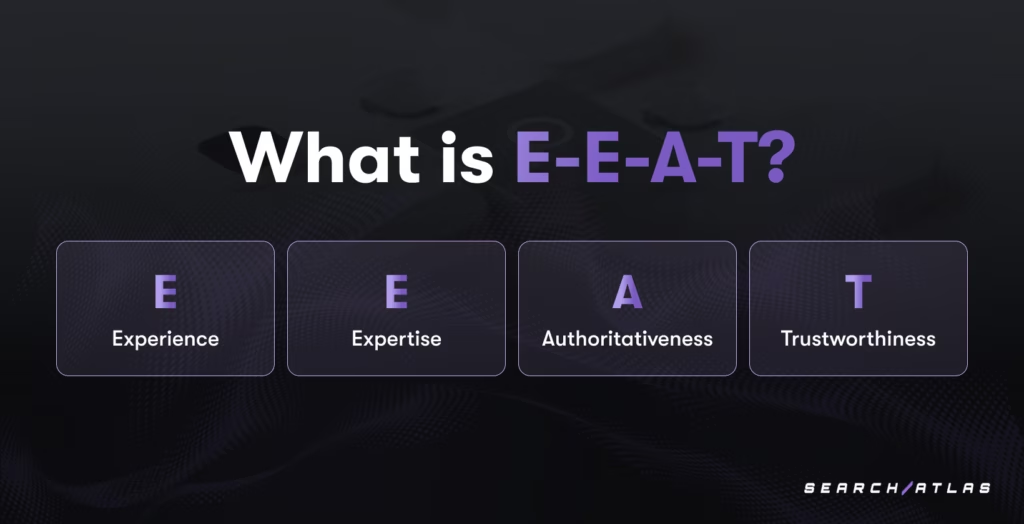
E-E-A-T, or ‘Double-EAT,’ stands for Experience, Expertise, Authoritativeness, and Trustworthiness. The four fundamental pillars of Experience, Expertise, Authoritativeness, and Trustworthiness form a core framework used by Google to evaluate content quality, reliability, and relevance in search results.
Originally evolving from Google’s earlier E-A-T concept, the addition of “Experience” highlights Google’s emphasis on authentic, firsthand knowledge and practical insights when assessing content quality.
Google emphasizes that E-E-A-T guidelines are used by search raters to help evaluate the performance of the various search ranking systems, and they do not directly influence ranking. Google uses these human ratings as feedback to improve its search algorithms, similar to how a restaurant might use customer feedback cards to enhance its service. The guidelines are valuable for content creators seeking to understand Google’s quality expectations.
Experience
Experience refers to the firsthand or life experience of the content creator with the topic being discussed. Google’s official blog post introducing Experience explains that this component evaluates whether content demonstrates the actual use of a product, having visited a place, or communicating personal experiences. Experience is important because it provides authentic, practical insights that theoretical knowledge alone cannot deliver.
Google recognizes that, in certain situations, users value content from someone with firsthand, life experience on the topic. For example, while tax advice might require an accounting expert, reviews of tax preparation software benefit from people with direct experience using different services.
Experience manifests through detailed observations, personal anecdotes, unique insights, and practical recommendations that come only from direct involvement with the subject matter.
Expertise
Expertise represents the specialized knowledge or skill in a particular field. The expertise pillar evaluates whether the content creator has the qualifications, education, or training to provide accurate information on the topic. Google highlights the importance of content created by experts or enthusiasts who demonstrably know their topic well.
Expertise provides credibility to the content by ensuring the information comes from qualified sources with a deep understanding of the subject. Google’s self-assessment questions for content creators specifically address whether the content is written by someone who knows the topic well. Their algorithms seek signals that demonstrate specialized knowledge through formal credentials, professional experience, or deep subject matter expertise developed through extensive study.
Expertise manifests in content through accurate technical explanations, careful analysis, proper terminology usage, and a thorough understanding of complex topics.
Authoritativeness
Authoritativeness measures the reputation and recognition of the content creator or website within its industry or niche. Google’s documentation encourages content creators to consider whether users researching their site would come away with an impression that it’s well-trusted or widely recognized as an authority on its topic.
Authority is established through backlinks from reputable websites, mentions in trusted publications, citations in academic papers, and recognition from acknowledged experts. In Google’s “Who, How, and Why” framework for content evaluation, authoritativeness connects to the “Who” aspect, or the identity and reputation of the content creator.
The authoritativeness pillar guarantees that information comes from sources widely respected and acknowledged as leaders in their field. Google evaluates whether content presents information with clear sourcing, evidence of expertise, and background about the author or publishing site.
Trustworthiness
Trustworthiness evaluates the accuracy, transparency, and reliability of the content and website. Google’s documentation identifies trustworthiness as the most important aspect of E-E-A-T. While the other components contribute to trust, content doesn’t necessarily need to demonstrate all of them equally. This places trustworthiness at the core of the E-E-A-T framework.
Trust indicators include clear contact information, transparent privacy policies, secure connections (HTTPS), accurate citations of sources, balanced presentation of information, and absence of deceptive practices. Google evaluators check for easily verifiable factual errors and consider whether the content meets the quality standard of appearing in respected publications like printed magazines or books.
The trustworthiness pillar ensures users can rely on content for making important decisions without fear of misinformation.
What’s the Difference Between E-E-A-T and E-A-T in SEO?
E-E-A-T represents the evolution of Google’s quality evaluation framework, expanding the previous E-A-T concept with an additional dimension focused on real-world experience. Google announced the addition of “Experience” as the first E in the updated E-E-A-T framework in December 2022 as part of their quality rater guidelines update.
The original E-A-T framework emphasized Expertise, Authoritativeness, and Trustworthiness as the primary pillars for evaluating content quality. The framework served Google well for years, helping systems identify high-quality content from authoritative sources. But while expert knowledge and authority are valuable, they don’t always capture the unique insights that come from firsthand experience with a product, service, or topic.
Google clarified that this isn’t a fundamental shift in their approach, but a refinement that better captures the diverse ways people seek and process information.
The distinction matters particularly for review content, how-to guides, and advice articles, where personal experience with the subject matter significantly enhances content quality.
For example, a review of project management software from someone who has integrated it into their company workflow provides more nuanced insights than a generic comparison from someone who has never used the tools. Similarly, travel guides benefit tremendously from being written by people who have actually visited the destinations they describe.
What is the Importance of E-E-A-T in SEO?
The importance of E-E-A-T in SEO for websites seeking long-term search visibility cannot be overstated. As Google’s helpful content documentation explains, their automated systems use many different factors to rank content, prioritizing those that seem most helpful after identifying relevant results. E-E-A-T represents the framework Google uses to identify this helpfulness.
Google clarifies that while E-E-A-T itself isn’t a specific ranking factor, their systems use various signals that collectively identify content with good E-E-A-T qualities. E-E-A-T influences rankings indirectly through quality signals that Google’s algorithms measure. E-E-A-T plays a necessary role in the website SEO strategy by establishing credibility and authority with search engines and users.
Google places particular emphasis on E-E-A-T for sensitive topics, giving more weight to content with strong E-E-A-T signals for topics that could significantly impact health, financial stability, safety, or societal welfare. These topics, classified as “Your Money or Your Life” (YMYL), require exceptional E-E-A-T signals to rank well.
Websites demonstrating high E-E-A-T typically experience improved user engagement metrics, including lower bounce rates and higher conversion rates, due to the trust they establish with visitors. Google’s E-E-A-T framework is a protective mechanism against low-quality or potentially harmful content, particularly for those sensitive YMYL topics that can significantly impact users’ well-being.
How to Improve Google E-E-A-T on Your Website for SEO?
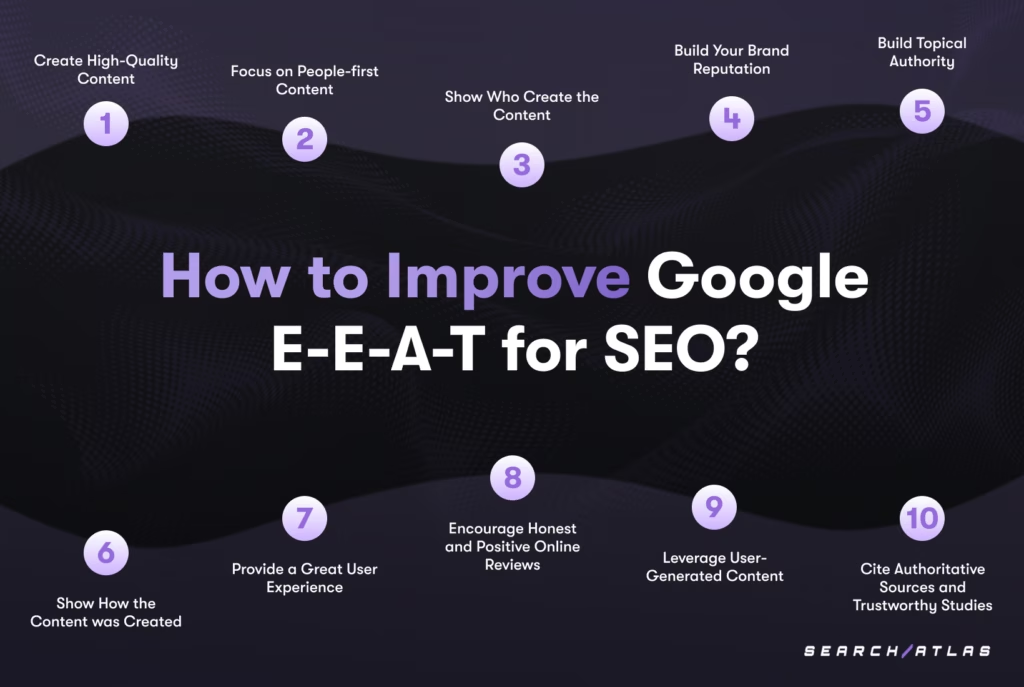
There are ten main strategies to improve Google E-E-A-T signals on your website for better SEO performance. E-E-A-T signals include demonstrable experience, verified expertise, established authority, and consistent trustworthiness throughout your content and website structure.
The 10 strategies for improving Google E-E-A-T on your website for SEO are listed below.
1. Create High-Quality Content
High-quality content refers to material that delivers exceptional value to users through relevance, comprehensiveness, accuracy, originality, and readability. High-quality content answers users’ questions completely, provides unique insights not found elsewhere, and presents information in an accessible, well-structured format.
High-quality content directly impacts how Google evaluates your expertise, authority, and trustworthiness. Search engines prioritize content that delivers substantial value compared to other pages in search results. When you create exceptional content, you establish credibility by demonstrating knowledge depth, attention to detail, and commitment to user satisfaction.
Google rewards content that provides original information, reporting, research, or analysis. To achieve this standard, follow the tips below.
- Conduct thorough research from multiple authoritative sources.
- Incorporate firsthand experiences with your subject matter.
- Provide comprehensive coverage addressing all aspects of the topic.
- Include insights exceeding the obvious information.
- Avoid simply copying or rewriting content from other sources.
- Structure your content with descriptive, helpful headings.
- Ensure your writing remains free from spelling and stylistic issues.
The Search Atlas Content Genius Tool helps content creators achieve these high-quality standards by providing an AI-powered SEO text editor that simplifies content creation and optimization. The Search Atlas Content Genius Tool offers integrated keyword research, SERP analysis, and NLP suggestions to help write SEO-optimized articles that align with E-E-A-T principles.

The Search Atlas Content Genius Tool analyzes top-performing content for any topic and identifies gaps in coverage through its competitor analysis features. By examining the top 20 ranking pages and providing metrics like content score, domain rating, schema implementation, and semantic terms used by competitors, the Search Atlas Content Genius Tool ensures your content demonstrates the depth and breadth necessary to establish strong expertise and experience signals for Google’s evaluation systems.
2. Focus on People-First Content
People-first content refers to material created primarily to satisfy human readers’ needs. People-first content addresses user questions, provides practical insights, and offers solutions to problems. It prioritizes delivering helpful information in an accessible, engaging format that resonates with the intended audience. Creating content like this aligns perfectly with Google’s E-E-A-T framework, especially the experience and trustworthiness components.
Google explicitly states in its documentation that automated ranking systems are designed to present helpful, reliable information primarily created to benefit people, not to gain search engine rankings. Content created with people in mind naturally demonstrates expertise and experience because it addresses users’ real questions and needs.
Google provides several self-assessment questions to determine if you’re creating people-first content. The self-assessment questions are listed below.
- Do you have an existing audience that would find this content useful if they came directly to your site?
- Does your content clearly demonstrate firsthand expertise and depth of knowledge?
- Will someone reading your content leave feeling they’ve learned enough about a topic to help achieve their goal?
- Does your site have a primary purpose or focus?
- Will readers leave feeling they’ve had a satisfying experience?
Affirmative answers to these questions indicate you’re on the right track with a people-first policy.
Avoid creating search engine-first content, which Google defines as content made primarily to gain search rankings
6 warning signs of search engine-first content are listed below.
- Producing content mainly to attract visits from search engines.
- Creating massive amounts of content on many different topics, hoping some will perform well.
- Using extensive automation without adding value.
- Summarizing others’ content without adding insights.
- Writing about trending topics solely for traffic.
- Creating content that leaves readers needing to search again for better information.
Google warns against writing to specific word counts based on misconceptions about preferred length, entering niche topics without real expertise, promising answers to unanswerable questions, or manipulating content dates to appear fresh when it hasn’t substantially changed.
3. Show Who Created the Content
Showing who created the content, or author transparency, refers to clearly identifying the person or team responsible for creating content and providing relevant information about their qualifications, experience, and background. Author transparency involves displaying author names, credentials, expertise, and professional experience prominently on articles, blog posts, and other content types.
Google’s “Who, How, and Why” content evaluation framework places significant emphasis on the “Who” aspect, making it clear who created the content and why they’re qualified to discuss the topic. Transparency about content creators helps users intuitively understand the E-E-A-T of the material they’re consuming. For YMYL (Your Money, Your Life) topics that could impact readers’ health, finances, or safety, author credentials become even more critical for establishing trust and authority.
Establish author attribution by following the best practicies listed below.
- Create detailed author bios with relevant qualifications, including education, certifications, years of experience, and professional affiliations.
- Include professional photos of authors to humanize content and build trust with readers.
- Link author names to dedicated profile pages containing more comprehensive information about their expertise, publishing history, and professional background.
- Include links to the author’s professional profiles on platforms like LinkedIn, industry associations, or academic institutions to provide additional verification of their credentials.
- Explain the collaborative process and identify key contributors with their specific areas of expertise for team-created content.
- Highlight specific qualifications that make the author an authority on the particular topic for specialized content.
- Include author information even on shorter content pieces where appropriate, as Google explicitly recommends adding accurate authorship information where readers might expect it.
- Update author information regularly to reflect new credentials, publications, or relevant experience that enhances their authority.
The absence of clear authorship raises red flags for users and search engines. Anonymous content or content with vague authorship attribution (e.g., “Staff Writer” or just a company name) fails to show the credibility that comes from individual expertise.
Google explicitly states in its documentation that adding accurate authorship information is strongly encouraged for content where readers would expect it. Even for topics that don’t require specialized expertise, identifying content creators helps establish accountability and authenticity, contributing to the overall trustworthiness of your website.
4. Build Your Brand Reputation
Brand reputation represents how people perceive your company or website in your industry. A strong brand reputation tells the users and search engines you are trustworthy and authoritative. To build your brand reputation, you need consistent quality content, active industry participation, mentions in respected publications, and positive customer feedback.
Brand reputation directly affects the authoritativeness and trustworthiness aspects of E-E-A-T. When other respected sources in your industry recognize your brand, Google sees this as evidence of your authority. What others say about you matters more than what you say about yourself. These third-party endorsements carry significant weight in how Google evaluates your E-E-A-T signals.
Strengthen your brand reputation by being consistent across all content and customer interactions. Join industry conversations through webinars, podcasts, and conferences. Get featured in respected industry publications and news outlets. Monitor your brand mentions online and respond quickly to feedback, especially addressing concerns or criticism professionally.
Off-page SEO techniques are vital for building brand reputation and boosting E-E-A-T signals. To use off-page SEO techniques effectively, focus on the 7 areas listed below.
- PR Campaigns. Create newsworthy stories about your innovations, research, or insights, then pitch them to relevant publications.
- Link Building. Earn links from high-quality websites in your industry through valuable content, not artificial link schemes.
- Guest Posting. Write articles for respected industry blogs to position yourself as a thought leader.
- Expert Participation. Join industry roundups, surveys, and panel discussions to increase your brand mentions on authoritative sites.
- Case Studies. Develop detailed case studies showing successful client outcomes that demonstrate your expertise.
- Speaking Engagements. Secure opportunities to speak at industry events to build authority and generate media coverage.
- Influencer Relationships. Connect with industry influencers who can share your content and validate your expertise.
Use the Search Atlas Outreach Campaign Tool to automate your outreach efforts and provide valuable links, guest posts, and relationships for your website. The Search Atlas Outreach Campaign Tool will help you meet the 5 objectives below.
- Create targeted campaigns to reach out to relevant bloggers and publishers.
- Streamline your link-building efforts by finding potential link opportunities based on keywords.
- Manage your outreach communications in an organized way.
- Follow up with prospects.
- Track your outreach campaigns and results.
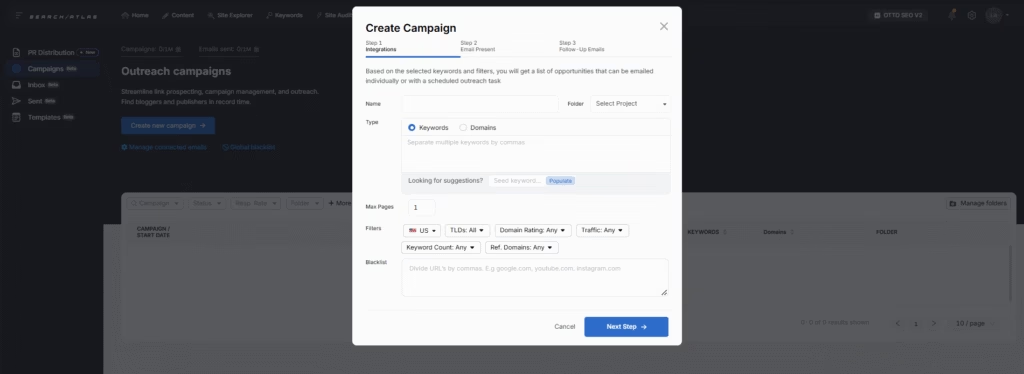
When using the Search Atlas Outreach Campaign Tool for E-E-A-T improvement, focus on reaching out to authoritative websites in your industry that would enhance your brand’s credibility. Connections with highly relevant, respected sites will provide stronger E-E-A-T signals than numerous links from less relevant sources.
The tool’s filtering options (Domain Rating, Traffic, etc.) can help you identify high-quality prospects that would contribute most significantly to your brand’s authority and trustworthiness in Google’s eyes.
5. Build Topical Authority
Topical authority refers to your website’s recognized expertise in specific subject areas. Building topical authority is about becoming the go-to resource for particular topics in your industry by demonstrating comprehensive knowledge and in-depth coverage.
When Google sees your site consistently publishing valuable content around specific topics, it recognizes you as an authority in those areas. This recognition leads to better rankings for related queries and establishes stronger E-E-A-T signals overall.
The 7 tips to build topical authority effectively are below.
- Create content clusters around main topics. Develop a pillar page that broadly covers your main topic, then create multiple supporting articles that explore specific aspects in greater depth. Interlink these pieces to show Google the relationship between your content.
- Map your content strategy to user journeys. Consider different stages of awareness and create content that addresses questions at each stage, from basic introductory content to advanced, specialized information.
- Conduct comprehensive keyword research within your niche. Look beyond high-volume terms to identify long-tail keywords and semantic variations that show you understand the topic’s nuances.
- Fill content gaps that competitors miss. Analyze what’s currently ranking and identify questions or subtopics that aren’t well-addressed. Creating content for these gaps demonstrates superior topic coverage.
- Maintain consistent content depth. Ensure your content explores topics thoroughly rather than superficially. Aim to provide information that can’t easily be found elsewhere.
- Update content regularly to include new developments, research, and industry changes. Updating content regularly shows ongoing expertise and commitment to accuracy.
- Showcase original research or data when possible. Publishing unique insights or studies establishes you as a primary source rather than just a curator of existing information.
Building topical authority creates a strong foundation for E-E-A-T that’s difficult for competitors to replicate quickly. It delivers long-term ranking benefits while providing real value to your audience.
6. Show How the Content was Created
Showing how the content was created enhances transparency and builds trust. Content methodology transparency means revealing the process behind your content creation. It includes explaining your research methods, data collection approaches, testing procedures, tools used, interviews, or personal experiences that informed the article.
Google specifically highlights it as the “How” component in their content evaluation framework. When readers understand the work behind your content, they can better assess its reliability and value. This transparency builds credibility with users and search engines by demonstrating thoroughness and commitment to quality.
Enhance content methodology transparency by including specific details about your process, listed below.
- For research-based content, explain your information sources, how you verified facts, and what experts you consulted.
- For product reviews, describe your testing methodology, including duration, conditions, and evaluation criteria. Include visual evidence such as photographs, screenshots, or videos that document your process.
- For AI or automation in content creation, make AI usage self-evident through clear disclosures at the beginning or end of content. Explain how AI tools were used in the creation process, whether for research, drafting, editing, or fact-checking. Most importantly, clarify why AI was valuable for this particular content and how human oversight ensured quality and accuracy.
- For scientific or medical content, detail your research methodology, data analysis techniques, and limitations of your findings.
- For how-to guides, explain your qualifications to provide instructions and whether you’ve personally performed the tasks.
- For news and current events, disclose your information sources, verification methods, and potential conflicts of interest.
- For opinion pieces, clarify your background and experience that inform your perspective.
Adding a simple “How We Created This Content” section can significantly improve your E-E-A-T signals while helping readers understand the value of your work. Even a brief explanation of your process shows your commitment to transparency and quality.
7. Provide a Great User Experience
User experience refers to how visitors interact with and perceive your website. A great user experience includes fast loading speeds, mobile responsiveness, intuitive navigation, and accessibility for all users. These technical elements work together with your content to create a seamless, satisfying journey for visitors. User experience directly impacts how long visitors stay on your site, whether they engage with your content, and if they return in the future.
A great user experience is essential for E-E-A-T because it directly affects the component of trustworthiness. When users encounter slow-loading pages, confusing navigation, or sites that don’t work properly on their devices, they quickly lose trust in the content, regardless of its quality. Google recognizes this connection, considering user experience signals like Core Web Vitals as part of their ranking algorithms. A site that’s difficult to use undermines its perceived expertise and authority, even when the content itself demonstrates deep knowledge.
Optimize user experience by focusing on the 5 key areas listed below.
- Page Speed. Compress images, minimize code, use browser caching, and leverage content delivery networks to ensure fast loading times across all devices.
- Mobile Responsiveness. Implement a responsive design that adapts to different screen sizes and touch interfaces, ensuring consistent functionality across devices.
- Navigation Structure. Create intuitive menus, logical information architecture, and clear paths to important content to help users find what they need quickly.
- Accessibility. Design for users with disabilities by adding alt text for images, using proper heading structures, ensuring sufficient color contrast, and making all functionality keyboard-accessible.
- Readable Content. Use clear fonts, appropriate sizing, sufficient spacing, and well-structured layouts that make content easy to scan and digest.
Tools like Search Atlas OTTO SEO Tool can help automate many technical aspects of user experience optimization. The Search Atlas OTTO SEO Tool automatically identifies and fixes technical issues that impact both user experience and search engine visibility.
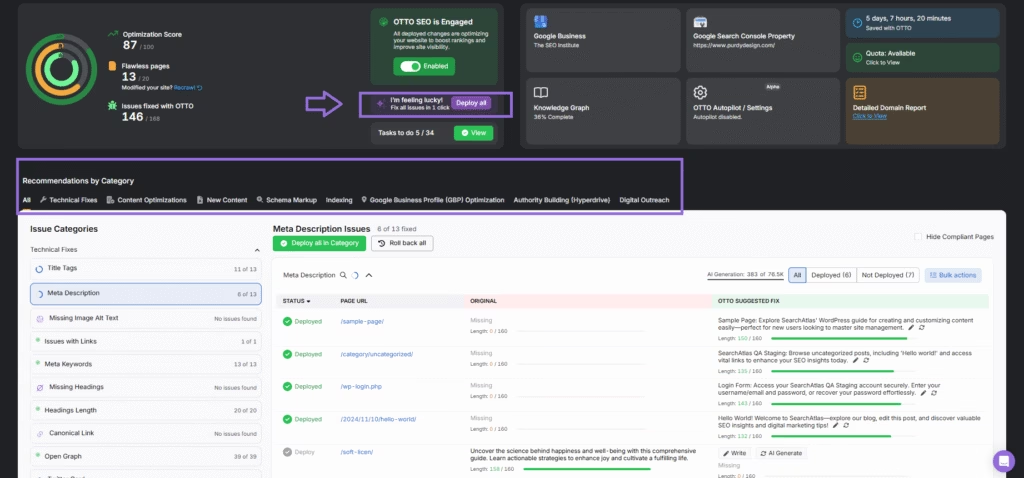
Search Atlas OTTO SEO’s automation is particularly valuable for addressing technical SEO elements that affect user experience at scale. The Search Atlas OTTO SEO Tool scans your entire website to identify broken redirects that cause delays, meta description issues that affect click-through rates, and schema markup opportunities that enhance how your content appears in search results.
By automatically deploying these fixes, the Search Atlas OTTO SEO Tool helps maintain consistent user experience standards across your entire site without requiring manual implementation for each page.
8. Encourage Honest and Positive Online Reviews
Encouraging honest and positive online reviews builds trust and demonstrates real-world validation of your products, services, or information. Online reviews serve as independent verification of your claims and credibility. Positive reviews from real users strengthen E-E-A-T signals by providing a third-party endorsement.
Generate authentic reviews by following up with customers after purchases or interactions, making the review process simple, responding professionally to all reviews (positive and negative), and showcasing testimonials prominently on your website. Honest reviews, even when critical, demonstrate transparency and commitment to improvement.
To effectively manage and respond to reviews at scale, consider leveraging tools such as the Search Atlas GBP Automations feature within the Search Atlas OTTO SEO Tool. This AI-powered feature allows businesses to automatically generate personalized replies, ensuring each review receives timely, relevant, and authentic attention.
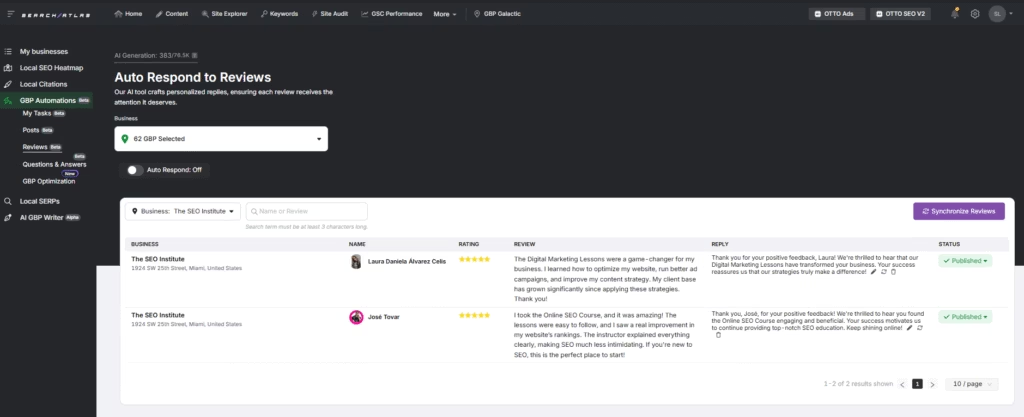
. Automating review management through the Search Atlas OTTO SEO Tool helps businesses maintain active engagement, build trust, and reinforce positive user experiences efficiently and authentically.
9. Leverage User-Generated Content
Leveraging user-generated content adds diverse perspectives and real-world experiences to your website. User contributions can enhance the experience component of E-E-A-T by showcasing actual users’ interactions with your products, services, or information. User-generated content provides authenticity that brand-created content sometimes lacks.
Incorporate user-generated content by enabling comments on blog posts, creating community forums, featuring customer stories, and including user submissions in your content. Moderate all user-generated content to ensure accuracy and appropriateness while preserving authentic voices.
10. Cite Authoritative Sources and Trustworthy Studies
Citing authoritative sources and trustworthy studies strengthens the credibility and accuracy of your content. Citations demonstrate research thoroughness and commitment to factual accuracy. Authoritative sources help build trust with users and show Google that your content is well-researched and reliable.
Strengthen citations by linking to respected industry publications, academic journals, government websites, and recognized experts. Include a mix of recent and established sources to demonstrate both currency and foundational knowledge. Properly formatted citations enhance content credibility and reinforce E-E-A-T signals.
What Are Some Website Examples With Strong E-E-A-T?
There are five website examples that demonstrate strong E-E-A-T implementation across different industries. These websites excel at showing experience, expertise, authority, and trustworthiness in their content and presentation.
The 5 website examples with strong E-E-A-T are listed below.
- Mayo Clinic demonstrates exceptional E-E-A-T in the healthcare sector. Mayo Clinic displays strong E-E-A-T through clear author credentials for medical content, extensive research citations, transparent editorial policies, and content created by practicing medical professionals. The Mayo Clinic website includes physician profiles with qualifications, specialties, and publications, building trust through demonstrated expertise.
- Wirecutter exhibits strong E-E-A-T in the product review space. Wirecutter demonstrates thorough testing methodologies, transparent affiliate relationships, detailed author bios highlighting relevant experience, and regular updates to reviews when new information becomes available. Their clear explanation of how products are tested and evaluated showcases firsthand experience.
- NerdWallet represents excellent E-E-A-T in the financial advice industry. NerdWallet establishes authority through content created by certified financial experts, transparent monetization disclosures, comprehensive comparison methodologies, and regularly updated information reflecting current financial conditions. Their financial tool calculators provide practical value while building trust.
- LinkGraph SEO Agency shows prominent E-E-A-T in the SEO and digital marketing space. LinkGraph demonstrates authority through case studies with verifiable results, content created by seasoned SEO professionals, transparent methodology explanations, and educational resources that showcase deep industry expertise. LinkGraph’s Search Atlas tools provide practical value while reinforcing their authority in SEO.
- Harvard Health Publishing exemplifies superior E-E-A-T in medical information. Harvard Health Publishing builds trust through content authored by Harvard Medical School faculty, clear editorial review processes, extensive research citations, and regular content updates reflecting the latest medical findings. Their institutional authority combines with the individual expertise of contributors to create exceptional E-E-A-T signals.
How Does Google Use E-E-A-T to Rank Content in Search Results?
Google uses E-E-A-T principles as a conceptual framework to evaluate content quality and determine search rankings. Google’s documentation explains that after identifying relevant content, its systems prioritize results that seem most helpful by analyzing factors that demonstrate experience, expertise, authoritativeness, and trustworthiness.
Google’s systems analyze numerous signals across the web to assess these E-E-A-T aspects. For experience, they look for evidence of firsthand interaction with products, services, or topics through detailed observations, personal insights, and practical advice that only comes from direct involvement. Google notes that some content might be helpful based solely on the experience it demonstrates, highlighting how this component can stand on its own merit.
For expertise, Google evaluates content depth, accuracy, and creator credentials. The algorithms look for signals that demonstrate specialized knowledge, through formal qualifications or demonstrated subject matter mastery. Authoritativeness signals include backlinks from respected websites, mentions in authoritative publications, and overall online reputation.
Trustworthiness, which Google identifies as the most important aspect, is evaluated through technical security measures, transparency in information presentation, and accuracy of content.
It’s important to understand that Google E-E-A-T is not a single score or metric, it’s a collection of signals that together help determine content quality and ranking worthiness.
Is E-E-A-T a Google Ranking Factor?
E-E-A-T is not a direct Google ranking factor but a conceptual framework that influences many actual ranking factors. Google clearly states in its documentation that E-E-A-T itself isn’t a specific ranking factor, clarifying a common misconception in the SEO community. Google’s systems do not assign a specific E-E-A-T score to websites or content.
Instead, E-E-A-T represents the characteristics and qualities Google’s algorithms seek to reward through various measurable signals. E-E-A-T influences numerous elements that directly impact rankings, such as content comprehensiveness, user engagement metrics, backlink authority, and technical site elements. Google ranking factors incorporate E-E-A-T principles through these various measurable signals that collectively assess content value and credibility.
Google further explains this relationship by noting that search quality raters provide insights on whether their algorithms are delivering good results. These raters use E-E-A-T as an evaluation framework, but their data is not used directly in ranking algorithms.
Is E-E-A-T More Important for YMYL Topics?
E-E-A-T holds significantly greater importance for Your Money Your Life (YMYL) topics due to the potential real-world impact of this information. Google confirms this in documentation, explaining that their systems give more weight to content with strong E-E-A-T for topics that could significantly impact health, financial stability, safety, or societal welfare. They specifically use the term “Your Money or Your Life” (YMYL) to describe these sensitive topics.
YMYL topics directly affect users’ health, financial well-being, safety, or overall welfare. Google applies more stringent quality standards to YMYL content to protect users from potentially harmful misinformation. The heightened scrutiny for YMYL topics reflects Google’s commitment to responsible information dissemination for topics with serious real-world consequences.
Financial advice, medical information, legal guidance, news on important events, shopping pages, and safety information face higher scrutiny from Google’s algorithms due to their potential impact. Websites covering YMYL topics need to demonstrate exceptional levels of experience, expertise, authority, and trustworthiness to rank well in search results.
Google emphasizes that trust is the most important component of E-E-A-T, and trustworthiness becomes especially critical when information could significantly impact users’ welfare. The tiered content evaluation allows Google to maintain appropriate quality thresholds across different content categories while applying stricter standards where misinformation could cause harm.
What is E-E-A-T Besides the Quality Rater Guidelines?
E-E-A-T represents Google’s content quality framework that extends past the quality rater guidelines into Google’s core search philosophy. While the quality rater guidelines introduce and define E-E-A-T for human evaluators, E-E-A-T principles permeate Google’s entire direction to search quality and content evaluation across all their systems and algorithms.
Google’s documentation on creating helpful content repeatedly references concepts that align with E-E-A-T without explicitly using the terminology, showing how these principles guide their algorithmic development.
Google’s content quality questions, such as whether content provides substantial value compared to other pages in search results, whether it’s professionally produced, and whether it demonstrates expertise, all directly connect to E-E-A-T concepts without explicitly naming them.
While the quality rater guidelines offer explicit definitions, E-E-A-T’s true significance extends to how Google designs its entire search system to reward content that demonstrates these qualities. E-E-A-T isn’t just a guideline but represents Google’s vision for what constitutes valuable, trustworthy content on the web.
What is E-E-A-T Besides AI-Generated Content?
E-E-A-T represents a universal content quality framework that applies to all content regardless of creation method, while AI-generated content presents specific challenges in meeting these standards that require special consideration.
Google’s February 2023 blog post on AI-generated content explicitly confirms that the “focus on the quality of content, rather than how content is produced, is a useful guide” when evaluating AI outputs. This statement reinforces that E-E-A-T principles apply universally, but AI content faces unique hurdles in demonstrating genuine experience and expertise.
The relationship between E-E-A-T and AI content centers on transparency about the creation process. Google emphasizes that for AI-generated content, the “How” component of their evaluation framework becomes particularly important. Content creators should clearly disclose AI involvement, explain how automation was used, and clarify why AI was beneficial for that specific content. This transparency helps build trust with users who might otherwise question the credibility of content they suspect was machine-generated without human oversight.
AI-generated content often struggles most with the experience component of E-E-A-T, as machines cannot truly have firsthand experiences with products, services, or topics. Human oversight and editing become essential to ensure AI outputs reflect genuine expertise and experiential knowledge.


